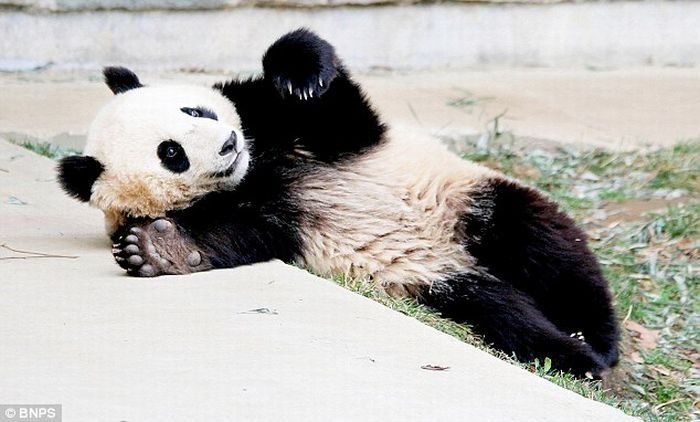|
|
Sleeping Panda
|
If twins are born, usually only one survives in the wild. The mother will select the stronger of the cubs, and the weaker will die. It is thought that the mother cannot produce enough milk for two cubs since she does not store fat. The father has no part in helping raise the cub.
When the cub is first born, it is pink, blind, and toothless. A giant panda cub is also extremely small, and it is difficult for the mother to protect it because of the baby's size. It nurses from its mother's breast 6 to 14 times a day for up to 30 minutes at a time. For three to four hours, the mother may leave the den to feed, which leaves the cub defenseless. One to two weeks after birth, the cub's skin turns gray where its hair will eventually become black. A slight pink color may appear on cub's fur, as a result of a chemical reaction between the fur and its mother's saliva. A month after birth, the color pattern of the cub's fur is fully developed. A cub's fur is very soft and coarsens with age. The cub begins to crawl at 75 to 80 days; mothers play with their cubs by rolling and wrestling with them. The cubs are able to eat small quantities of bamboo after six months, though mother's milk remains the primary food source for most of the first year. Giant panda cubs weigh 45 kg (100 pounds) at one year, and live with their mothers until they are 18 months to two years old. The interval between births in the wild is generally two years.
In July 2009, Chinese scientists confirmed the birth of the first cub to be successfully conceived through artificial insemination using frozen sperm. The cub was born at 07:41 on 23 July that year in Sichuan as the third cub of You You, an 11-year-old. The technique for freezing the sperm in liquid nitrogen was first developed in 1980 and the first birth was hailed as a solution to the problem of lessening giant panda semen availability which had led to in-breeding. It has been suggested that panda semen, which can be frozen for decades, could be shared between different zoos to save the species. It is expected that zoos in destinations such as San Diego in the United States and Mexico City will now be able to provide their own semen to inseminate more giant pandas.
Attempts have also been made to reproduce giant pandas by interspecific pregnancy by implanting cloned panda embryos into the uterus of an animal of another species. This has resulted in panda fetuses, but no live births.
|
|









